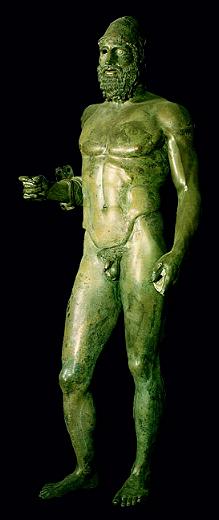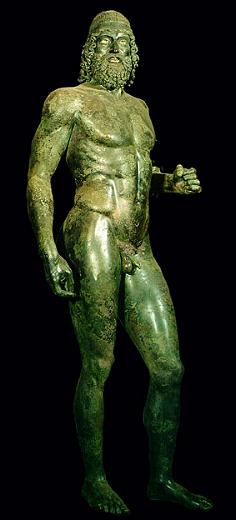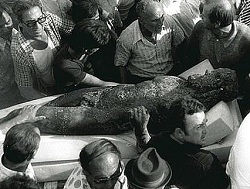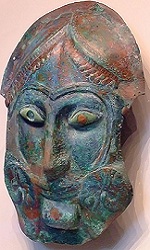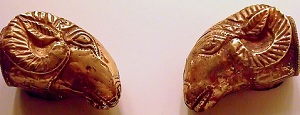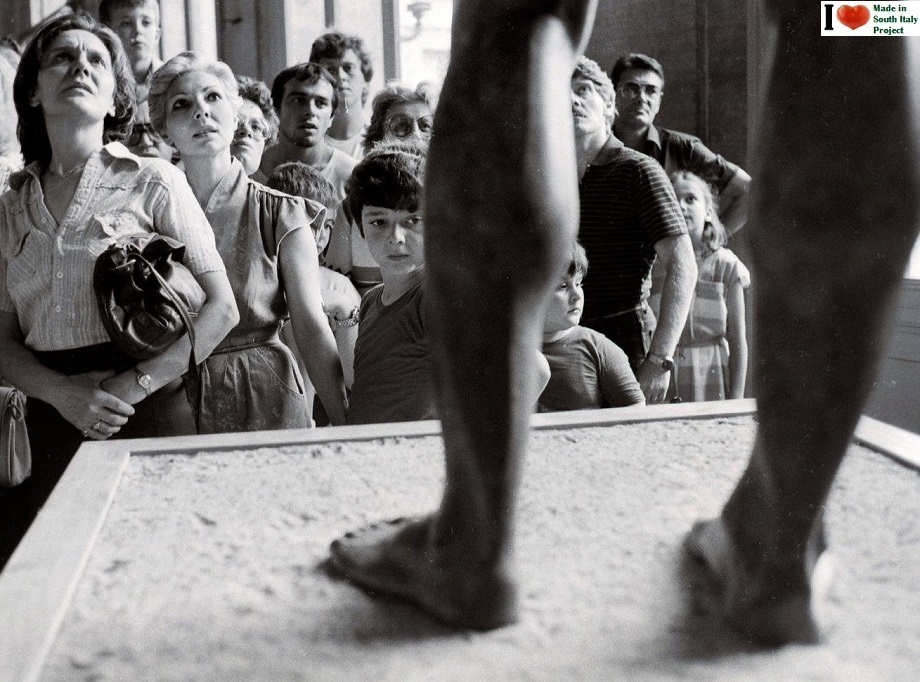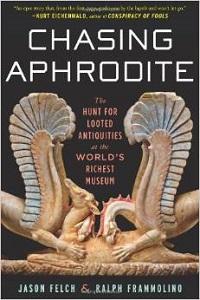|
The presence of the statues on the sea depths, seems the effect of a boat's falling during the Roman age: the Romans, after having conquered Greece, stole the great artistic patrimony, and moving it through a low coastal navigation, along the safer open sea roots of the Ionian coast.
A transportation towards Rome is objectionable, even if the Bronzi belonged to a Great Greece town, such as Tarrant (Taranto-Apulia) but, if we place them in Locri Epizephiri, it would be harder to understand why the statues were more than 30km north and in the opposite direction of the way to go, one theory is that the removal of the statues took place during the theft of Locri in 275 B.C, by Pirrus, the Epirus' king.
It is more probable that the statues were tossed overboard, either to lighten the ship's load in a storm or to prevent them falling into the hands of pirates.
The statues are of two virile men, presumably warriors or gods, who possibly held lances and shields at one time .
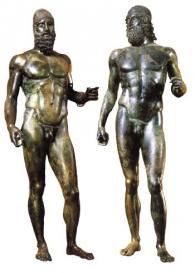
At around two meters, they are larger than life. The 'older' man, known as Riace B, wears a helmet, while the 'younger' Riace A has nothing covering his rippling hair.
Both are naked. Although the statues are cast in bronze, they feature silver lashes and teeth, copper red lips and nipples, and eyes made of ivory, limestone and a glass and amber paste.
Italy is renowned for its archeological treasures but the Riace bronzes have attracted particular attention.
This is partly because of their exceptionally realistic rendering and partly owing to the rarity of ancient bronze statues, which tended to be melted down and the metal reused.
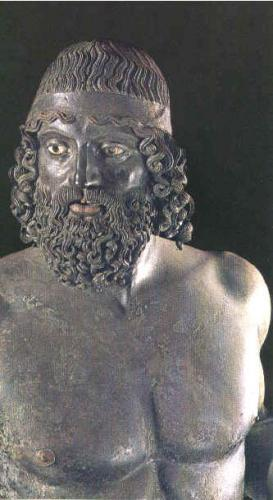 Mariottini, who spotted the statues 300 meters off the coast and eight meters underwater, said the bronze was so realistic he initially thought he'd found the remains of a corpse. Mariottini, who spotted the statues 300 meters off the coast and eight meters underwater, said the bronze was so realistic he initially thought he'd found the remains of a corpse.When they first went on display in 1981, a million people came to see them and the pair were even featured on a commemorative postage stamp.
Today the statues pull some 130,000 visitors each year to the Reggio Calabria museum housing them. How or when the statues sank to their watery resting place also remains a mystery, as divers uncovered no wreckage in the vicinity.
In the fantasy of the public at large the two "champions" exemplified the quality of manliness, their "miraculous" reappearance from the waters having touched everyone's unconscious.
Archeology, however, is a more concrete matter; lets try to learn a bit more about these two splendid statues, among the few surviving original, antique bronze sculptures.
As a consequence, the right thigh stands in an upper position than the left one: such movement in the Bronze A, doesn't involve the upper part of the thorax, where pectorals and shoulders are in an almost horizontal position,while,in the bronze B, it involves both the pectorals, defined by a tilted line, and on the shoulders: the right one is in a lower position than the other.
The bodies : The two statues show a crossed rhythm pondeal system: the leaned left arm,to hold the heavy shield, finds a correspondence with the vertical right leg, supporting the body's weight; the right arm, while the lower right arm, holding the mast, finds a correspondence with the flexed left leg, in an advanced position.
The powerful muscles are made stronger, thanks to the plastic vigor, in a more geometrical and static way as for the Bronze A, while it's more analytical and dynamical in the Bronze B.
Among the anatomical accurate reproduced particulars in the Bronzi, we can see the sub-skinned veins, particularly appreciated in the hands and in the feet.
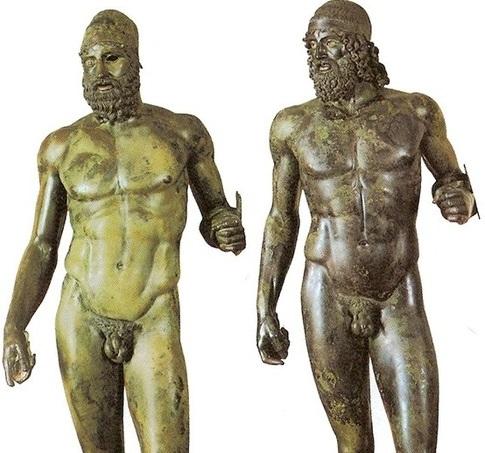
Even the pinked colored nipples (not obtained by copper, but in a low concentration of lead), separately manufactured, and applied through the hammered technique, are interesting.
The nakedness,allowed to put in evidence the human body's beauty, considered both an essential element of the “virtue”, and the intellectual and moral capabilities.
For this reason, the nakedness was the ideal way to represent divinities, heroes, but also the athletes, not just because they played naked, but because, in case of victory, they received the hero's honors.
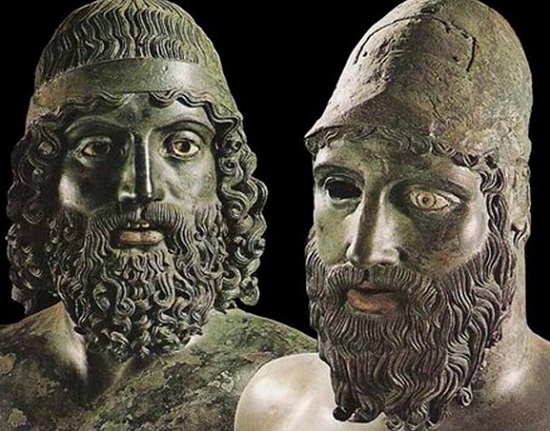
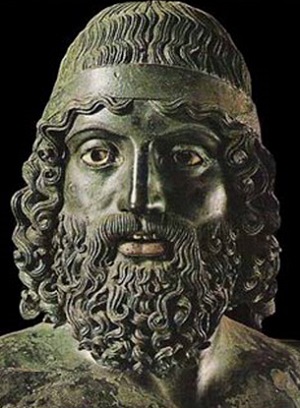
The “A”statue's head. The head is characterized by a refined shave, with strongly plastic sinuous wisps, and the hair, withheld with a large band.
The long wisp of waved hair, sulking all the scalp, falling into curled wisps on the shoulders, makes us suppose the head was in origin devoid of the helmet; on the top, there is a hollow, maybe for a meniscus, a functional bronzed tip, to keep the birds away from the statues.
Nevertheless, in a second time, a Corinthian helmet was placed, as stated by a standing signs, and the transformation of the original hollow into an inlet for the same helmet. In that time, the well shaped ears,were covered by applied wisps.
The mouth shows coppered lips and an upper row of five teeth, shaped in a silver foil.
The eyes show a bronzed foiled lashes, and ivory corneas while the irises, not kept, were probably in glassed pasta or of a precious stone.
The Bronze A would represent Tideus, so fierce to bite his enemy and devouring his brain (hence the visible silver teeth);
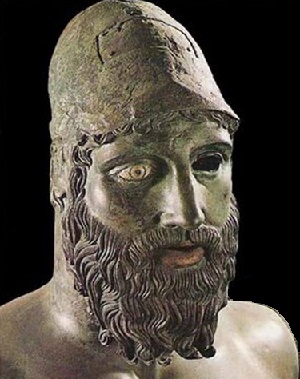 The “B”statue's head. The head is smooth and deformed, probably because it had a raised Corinthian helmet, and covered by a leather or a felt cap; we can see some plate cats, covered by little hammering and the sulk on the sides of the shave the lower side of the throat. The “B”statue's head. The head is smooth and deformed, probably because it had a raised Corinthian helmet, and covered by a leather or a felt cap; we can see some plate cats, covered by little hammering and the sulk on the sides of the shave the lower side of the throat.
The ears' lower lobes and hairs wisps came out of the cap, and were similar to the shave's ones, not so thick, and plastic.
Even the mouth has the coppered lips; we only have the right eye, with the white marbled cornea, the iris, made up of a whitish ring and a pinkish one, and the black eye pupil.
The Bronze B, would be Anfiarao, who forecast his own death thanks to his prophetic spirit (recalled by the cap, worn by seers).
Other elements differentiate them.
Apart from differences in the face, hairstyles and beards, the right hip of statue B is considerably displaced, attributing this statue to the generation directly following that of statue A.
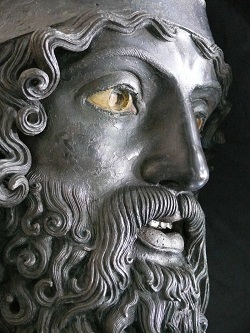 The creation -The Bronzi have been created through a compartments' welding, separately cast: head, thorax, arms (divided into three sectors), hands, legs, feet, feet's medium fingers. The creation -The Bronzi have been created through a compartments' welding, separately cast: head, thorax, arms (divided into three sectors), hands, legs, feet, feet's medium fingers.
A widespread opinion is the Bronzi were performed by two sculptors, working in different chronological periods.
The hypothesis of their creation in Attica, in the Phydia's environment, author of the sculpture's decoration of the famous Parthenon of Athens, is confirmed.
The A statue, would have been performed around the half of the 5 th century B.C, while the B one, with a new artistic sensibility, whose main author was Polycletus, 30 years after.
Their same stance, the close analogy of the metal alloys used, the fusion technique and the expertise shown in the metal inlay used for certain touches (the areolas, lips and teeth) all lead us to the origins and original purpose.
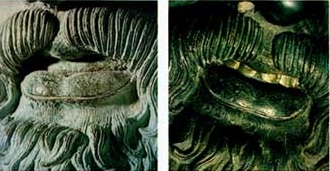
?How could we otherwise explain the survival of these characteristics for about 30 years?
All the more so because these 30 years fall in the richest, most vibrant and the most innovator period of the 5th. BC in the classical environment enveloping Phidias and the great Parthenon workshop.
Expert have not reached a final unanimous opinion but it is highly likely that the two bronze statues were commemorative offerings, erected by the winners of the "oplitodromies" (races between athletes in heavy armour introduced in Athens in 520 BC and run until Hellenistic times).
The prestige earned by the winners of these races lived on as long as their monuments.
|
|
Museo Archeologico Nazionale della
Magna Grecia di Reggio Calabria.
|
|
| Gioia Tauro "METAUROS" museo archeologico. |
|
| LOCRI EPIZEFIRI |
|
Was there a "brother or brothers"
when the statues were found.?
Some experts think so...up to 5 of them
|
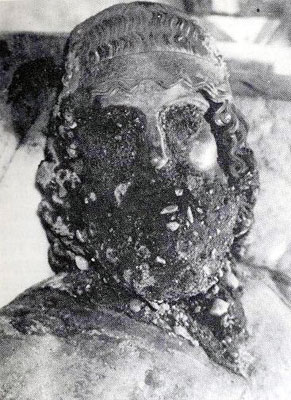 ANSA - Rome, August 17 - 2007 - Thirty-five years after the famed Riace bronzes emerged from the sea, a probe into a third ancient statue thought to have gone missing at the time is gathering pace. ANSA - Rome, August 17 - 2007 - Thirty-five years after the famed Riace bronzes emerged from the sea, a probe into a third ancient statue thought to have gone missing at the time is gathering pace.
Prosecutors, investigating the claims of local art sleuth Giuseppe Bragho', say there is growing evidence that a third work of art was smuggled from the scene during the discovery.Bragho', an expert on his local Calabria region where the sensational bronzes appeared in 1972, says he has "tracked down and photographed a series of documents that indicate an alarming scenario".
|
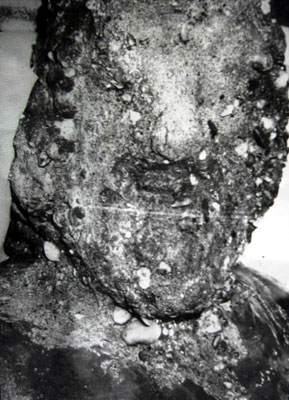 He says a third statue - "completely different from the other two" - as well as two shields and a lance, were seen lying on the seabed by the finder, scuba diver Stefano Mariottini. He says a third statue - "completely different from the other two" - as well as two shields and a lance, were seen lying on the seabed by the finder, scuba diver Stefano Mariottini.
Bragho' points to a statement made by Mariottini the day after he discovered the statues on 16 August 1972.
In the statement, he refers to "a group of statues presumably of bronze" (un gruppo di statue presumibilmente in bronzo).Mariottini also says the "two protruding statues were free of any clear incrustations".
Yet Bragho' has found a previously unpublished photograph of the statues apparently showing one of the figures entirely covered in incrustations, its features indistinguishable.
|
|
Original document signed by Mr Mariottini stating that: "Le statue sono di colore bruno scuro salvo alcune parti piu' chiare, si conservano perfettamente, modellato pulito, privo di incrostazioni evidenti...)
In english: " The statues are dark brown in color except for some parts where they look clearer, they are perfectly preserved, clean, and free of any visible incrustation ...)
|
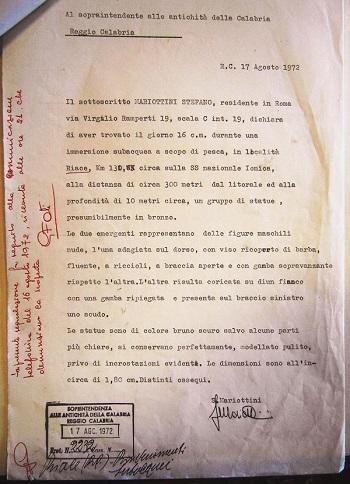 |
|
Bragho' also highlights another section of Mariottini's statement in which he reportedly said he saw " a group of statues, probably made of bronze...one of them lying on its side with a shield on its left arm".
|
|
(Le due emergenti rappresentano delle figure maschili...l'altra presenta sul braccio sinistro uno scudo...
The two protruding figure are male the other has a shield on left arm.)
In addition, the expert has provided prosecutors with the name of a man who allegedly helped smuggle a shield and lance away from the scene of the discovery.
As further evidence of his theory, Bragho' has produced a series of recordings of a male voice, who claims he acted as a mediator for representatives of the John Paul Getty Museum in Los Angeles.
Bragho' believes that the alleged weapons and possible third bronze ended up in the museum's collection.
However, the institute has vigorously denied the claims, categorically stating: "the spear, shields and helmet purportedly found with the bronzes have never been part of our collection.
"This information is wrong and must be corrected," the museum said.
|
|
Statement from the J. Paul Getty Museum Regarding the Riace Bronzes - 03/02/07
"In recent weeks, there have been reports in the press suggesting that pieces from the Bronzes of Riace (a shield, lance, and helmet) might currently reside at the J. Paul Getty Museum. This information is wrong and should be corrected. These objects, that are suggested to be part of the Riace Bronzes, have never been in the Getty Museum's collection.
Julie Jaskol
|
|
Some of South Italy exhibits "acquired" by the Getty Center now on display in the galleries. Photographed at the Getty Villa in Malibu, California , by Mary Hrrsch and posted on Flicker.
|
|
Left to right :
1) Ceremonial Helmet Made in South Italy 350-300 BCE Bronze
2) One of two Prometopidia (headpieces) that covered a horse's forehead and nose as part of its battle armor.
3) Pair of Ram's-Head finials.
|
|
|
|
The Goddess Goes Home
|
|
MAY 23, 2011-The Getty Museum's famous statue of Aphrodite has gone home from the Villa in Malibu to a small town in Sicily, and the Getty, along with other US museums, no longer buys looted antiquities from a criminal underground.
|
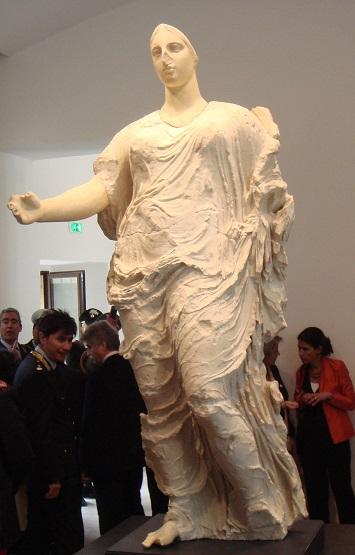 |
|
The return of this statue is very important. It is like a piece of our culture, a piece of our country.
|
|
|
|
Malibu location
|
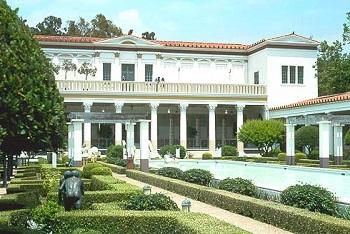 |
|
The Getty Center in Los Angeles
|
 |
|
ROME, Sept. 25 - 2012 — In a low-key ceremony, the Italian Culture Ministry and the J. Paul Getty Museum of Los Angeles signed an agreement here on Tuesday under which the museum will hand over 40 archeological artifacts that Italy says were looted from its soil.
It was an anticlimactic coda to nearly two years of highly charged negotiations that broke down several times, with Italy threatening “a cultural embargo” against the Getty unless it surrendered the items.
In a joint statement, the Getty’s director, Michael Brand, said the museum’s scholarly research had shown that the artifacts’ “proper home is in Italy.” The accord on the pieces was announced in August.
Looming over Tuesday’s signing was the Italian trial of a former curator of antiquities at the Getty, Marion True, who has been charged with conspiracy to acquire looted artifacts. “We know the restitution will involve pain for the museum, but also opens up new possibilities,” said Mr. Brand, who attended the signing in Rome.
The fate of a disputed bronze statue of an athlete found at sea, which Italy says was illegally exported after being hidden in that country and that the Getty contends was found in international waters, awaits an Italian court’s decision.
In its accord with Italy, the Getty rejects any suggestion that it knowingly acquired looted artifacts. Still, the pact does not protect the museum from future investigations.
|
|
Within the past five years, museums have returned to the Italian and Greek governments more than 100 artifacts worth nearly $1 billion.
The Met gave back 21 pieces, including its celebrated Euphronios krater, a Greek vessel dating to about 515 B.C., which the museum had acquired in 1972 for a then-record $1 million.
The Boston MFA returned 13 objects, including a statue of Sabina, wife of the second-century A.D. Roman emperor Hadrian.
In no case did a museum acknowledge wrongdoing on its part, and, in a historic shift, the Italian government agreed to make long-term loans of other antiquities to take the place of those that had been repatriated.
The Getty gave back more objects than any other museum—47, nearly a dozen of them masterpieces—and the last piece to go was its iconic goddess.
The story of the statue stands as a case study of how longstanding practices in the market for Greek and Roman antiquities were overtaken by changes in attitude, the law and law enforcement.
A new book tells the story of beauty, corruption and the waste of millions of dollars.
"The book (Chasing Aphrodite) traces the Getty Museum's illegal acquisition of antiquities..
|
|
On august 21-2012 a bronze sculpture depicting a golden lion was found in the sea in Calabria off Cape Zeffirio by Leo Morabito and Bruno Bruzzaniti. (Coincidentally the statues were discovered on August 16 - 1972).
|
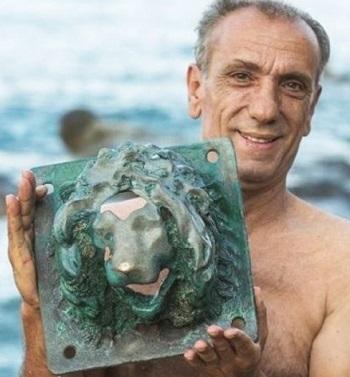 |
|
Also found by Bartolo Priolo was a bronze Armour wedged between the rocks not far from where the Riace Bronzes were located years back....NOTE : The news of a new "treasure" found in Calabria still does the rounds on the www, but is not true...unfortunately.
|
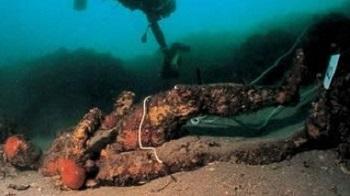 |
| |
|

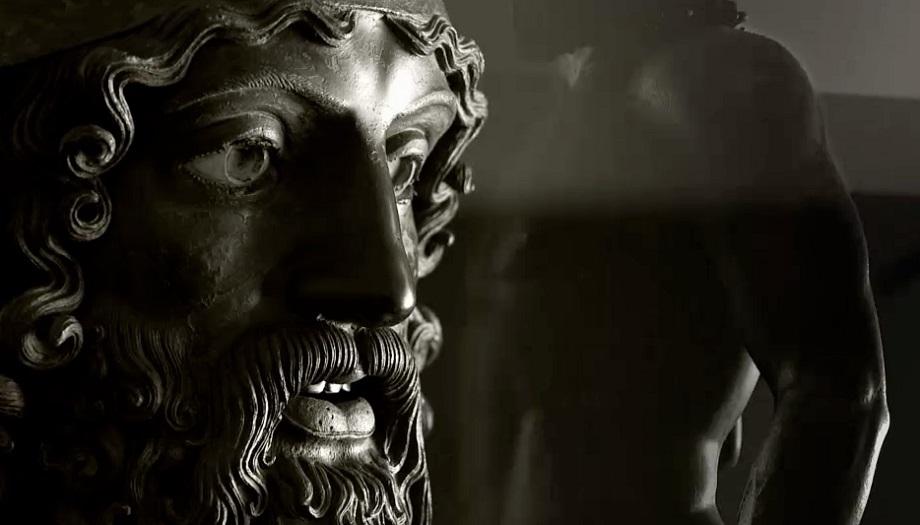
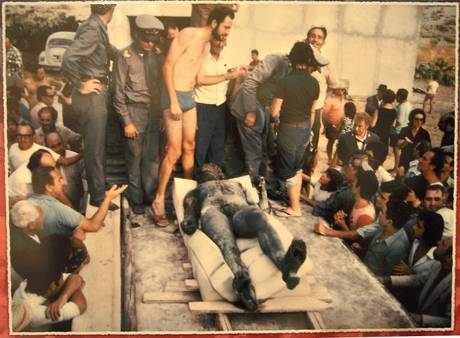
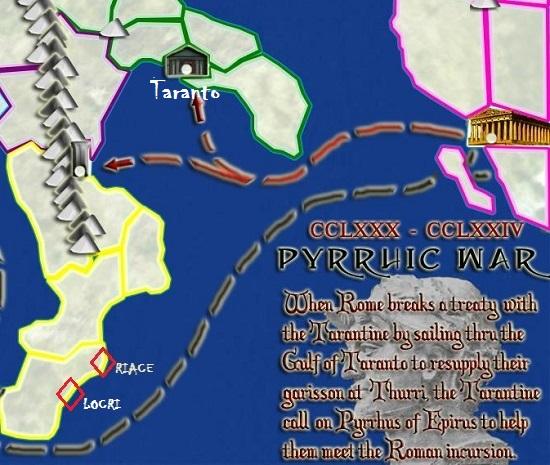
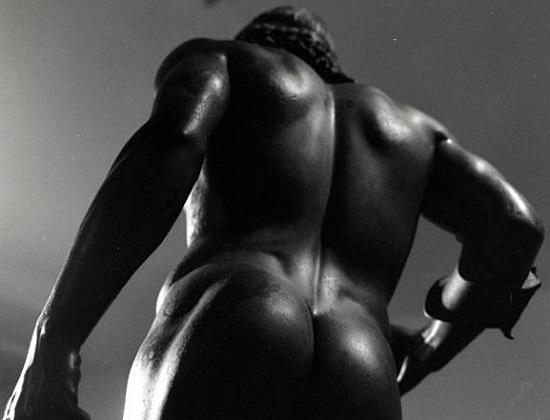


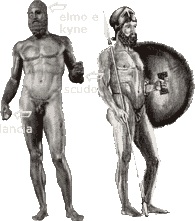
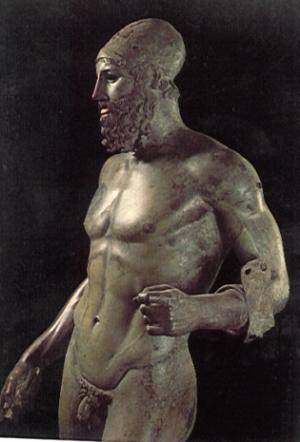




 The creation -
The creation -
